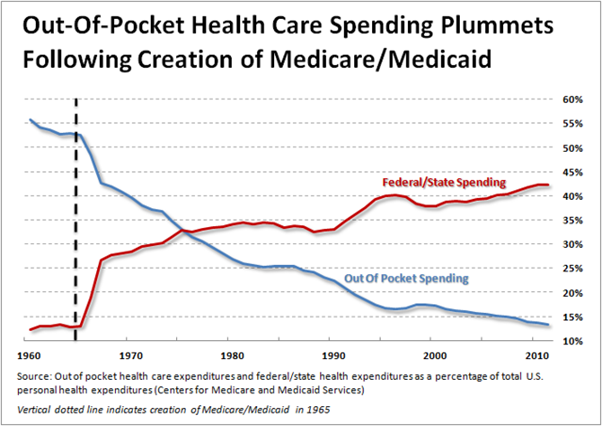- As global stock markets continue to rise, commentators talk of a bubble
- Longer-term indicators present mixed signals about valuation
- Expectations about the speed of economic recovery from the pandemic are key
- A recovery in productivity growth relies on saving and investment in innovation
This is the first of a two part letter reviewing the current valuation of stocks. The focus is US-centric and will investigate both long-run valuation (Part 1) and shorter term factors which may be warning signs of irrational exuberance (Part 2).
During the last 12 months we have seen stock markets around the world, decline rapidly and then rebound. Technically the longest bull-market in history ended in March of 2020 but the recovery was so swift that many commentators are calling it merely a sharp correction, simply an aberration. Since March the US stock market, fuelled by aggressive monetary and fiscal easing, has shot to new all-time highs. Q4 of 2020 witnessed the approval of the first Covid-19 vaccines, sending markets higher still.
Equity markets are forward-looking, the economic woes of today are discounted, expectations of recovery, backed by further fiscal support, make the prospects for future earnings appear relatively rosy. In this, the first part of my, letter I want to examine the arguments for a continued rise in equity prices together with the counter-claim that a repeat of the performance of the past decade is simply inconceivable.
Every stock index is different but, for the purposes of this research, I will focus on the US rather than the rest of the world, since it is the US market which has tended, historically, to set the global tone. The chart below looks at the forward PE ratio of the US (in red) and the MSCI World – Ex-US (in blue): –
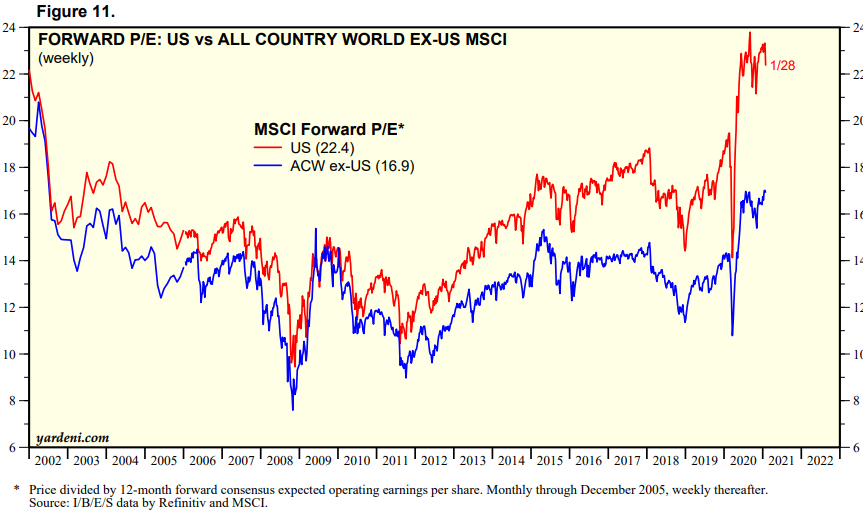
Source: Yardeni
Looking at the evolution of earnings per share and incorporating the recent forecasts for 2020 and 2021, we get a picture of a market which might just have got a little ahead of itself: –
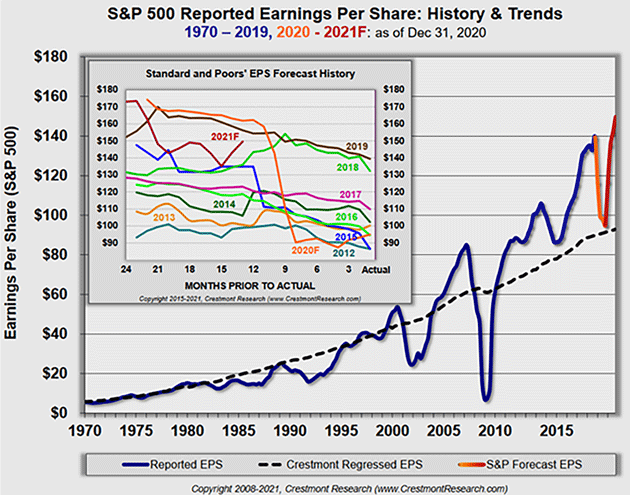
Source: Crestmont Research
Part of the explanation for the substantial outperformance of the US has been the scale of the fiscal and monetary response of the US administration and its notionally independent central bank, yet, as the infographic below reveals, the US response whilst substantive is relatively less dramatic than that of some other countries: –
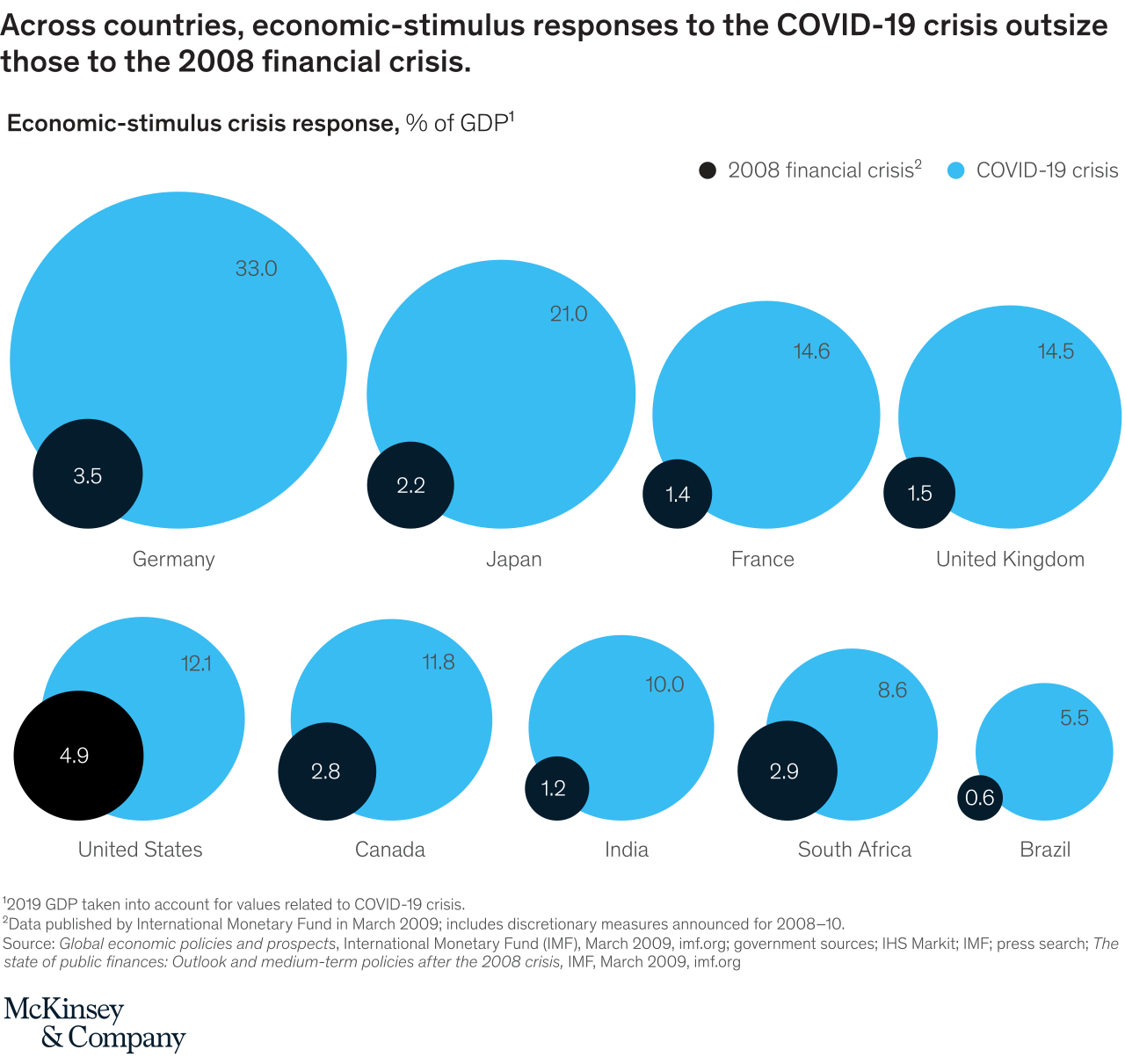
Source: McKinsey
Many commentators are concerned that the stock market (especially in the US) is over-valued, however a more nuanced view is provided by veteran equity market practitioner, Gregory van Kipnis. Writing at the beginning of last month in AIER, he makes a number of important observations in his article – Angst Over High Price-Earnings Levels Likely Misplaced. Stating from the outset that his purpose is not to provide valuation advice but a perspective on approaches to earnings valuation, the author looks at a variety of alternative valuation methodologies before reaching his conclusion: –
Market pundits who focus on PE, PE[-12], PE[+12] have come to the conclusion that the US stock market, as measured by the S&P 500, is overvalued and due for correction. Some believe we are in a bubble and there will be a sharp correction. Others opine that from current levels we are headed for a low rate of market performance for the next 10 years. These views may turn out to be correct.
However, a more formal analysis of classic valuation theory that relates the current price level to the present value of the future stream of expected income suggests otherwise; that is, the market is more fairly valued and in keeping with its historical norms. From a statistical point of view, there is uncertainty around such a conclusion. Market returns routinely fluctuate. Two thirds of the time total returns realized in the market fluctuate by plus or minus 4.4%. Nonetheless, there is analytical support for the conclusion that from both a market efficiency point of view and from the perspective of long-term valuation theory, the market is roughly aligned with long-term norms.
The chart below shows the S&P500 cumulative compounded total return at constant rate. The blue dotted line shows theoretical ‘fair-value’ derived from the author’s Total Return Model.
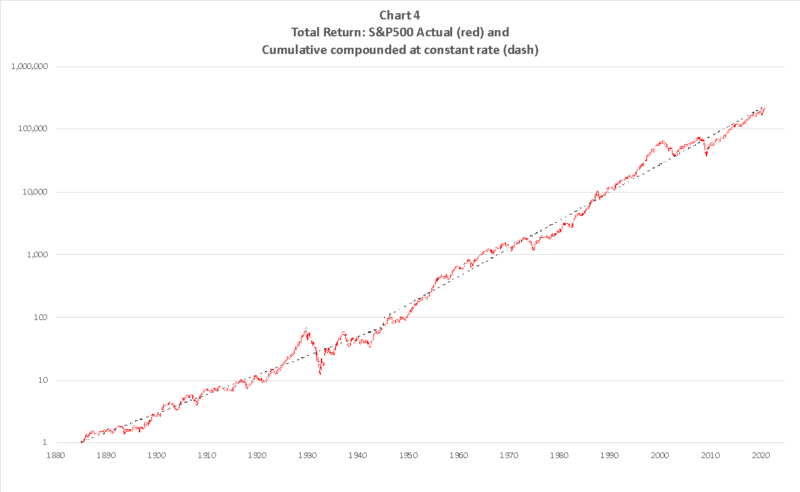
Source: AIER
Van Kipnis continues: –
At the risk of seeming repetitive, it should be stressed that the market trades within a range around its long-term fair value norms. For sure prices have trended for long periods below and above the historical norm. But it cannot be dismissed lightly that those historical norms are real and give every appearance of remaining intact for the foreseeable future.
Value amid the Growth
I have written on a number of occasions about the return of the Value investor, however, we are in a different environment from the 1980’s, where small cap stocks outperformed. The evolution is best explained by Robert Zuccaro, CIO of Target QR Strategies, who made the following observation in his January investor letter: –
Major differences are apparent between the economies of 1980 and 2020. Most companies in 1980 were industrial in nature and domestic in scope. In acknowledgement of the heavy influence of industrial companies in economic activity, the S&P 400 in this era was comprised solely by industrial stocks. Globalization has dramatically altered both the economy and the stock market. Whereas business activities were principally domestic in scope in the past, globalization offers an opportunity that is five times greater than the domestic market. Secondly, tech companies possess the capability to ramp up sales and profits faster than ever before. For example, it took Apple 31 years to reach a market cap of $100 billion. DoorDash which just came public did this in just 7 years. Forty years ago, some small companies starting from a small sales base were able to generate sales and profits growth up to 30-40% each year. Today, large cap tech companies with global reach can generate growth rates of 100%.
Vitaliy Katsenelson discusses the Growth versus Value debate in greater detail in – Value & Growth Demagogues – the author begins: –
I have a problem with both growth and value demagogues.
Growth demagogues will argue that valuation is irrelevant for high-growth companies because the price you pay for growth doesn’t matter. They usually say this after a very extended move in growth stocks, where these investors look like gods that walk on water. They call value investors “accountants.”
Katsenelson goes on to explain that he analyses corporate earnings looking four years ahead in order to capture the value in high growth stocks, nonetheless he believes many growth stocks as insanely overvalued.
On February 4th, Goldman Sachs, chief global equity strategist, Peter Oppenheimer expressed a more sanguine opinion on growth: –
We believe that we are still in the early stages of a new bull market, transitioning from the ‘hope’ phase (which typically starts during a recession, led by rising valuations) to a longer ‘growth’ phase as strong profit growth emerges.
The client note went on to discuss six areas which could benefit from capital inflows if investors start to price in higher inflation expectations: –
- Equities relative to bonds
- Value relative to growth
- Cyclicals relative to defensive
- Banks relative to staples
- High volatility relative to low volatility
- Dividends
To date, roughly 70% of US companies have reported Q4 results, of these, around 85% have beaten expectations. Before you rush to buy remember the stock market is much happy travelling than arriving, the good earnings news is largely contained in the current price.
The Overvaluation Argument
Notwithstanding the analysis of van Kipnis and the forecasts of Goldman Sachs, the arguments for irrational exuberance are compelling. The catastrophic damage caused by the pandemic has yet to be fully revealed and a long-term secular stagnation remains a clear and present danger.
In his Forecast 2021: The Stock Market – John Mauldin takes a less rosy approach to current valuation: –
We all know the stock market was up significantly last year, and even more so around year-end, but you may not know how historically wild this is.
Citi Research has a “Euphoria/Panic” index that combines a bunch of market mood indicators. Since 1987, the market has typically topped out when this index approached the Euphoria line. The two exceptions were in the turn-of-the-century technology boom, when it spent about three years in the euphoric zone, and right now.

Source: Peter Boockvar, Pinnacle Data, Haver Analytics, Citi
Another measure of overvaluation is the ratio of Equity Market Capitalisation to GDP, often referred to as the Buffett Ratio, since it is favoured by the Sage of Omaha: –
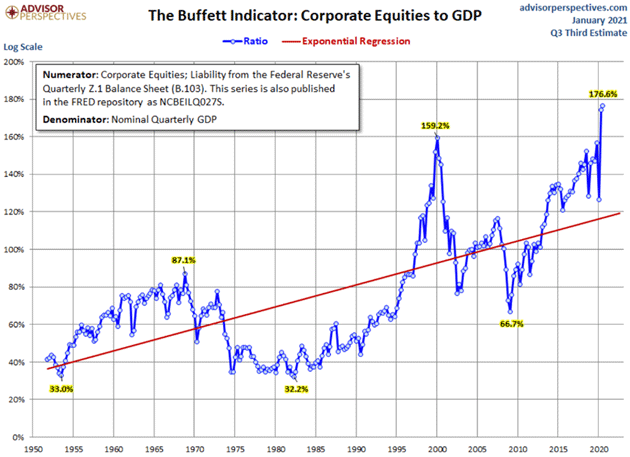
Source: Advisor Perspectives
I have a couple of issues with this ratio; firstly, as interest rates fall, so the attractiveness of debt relative to equity capital increases, and secondly, as a result of this fall in the cost of borrowing, less equity is issued and more equity is retired through mergers, de-listings and share buy-backs.
In the aftermath of the pandemic a number of governments prohibited share buybacks by key institutions, in the September 2020 quarterly review from the BIS – Mind the buybacks, beware of the leverage the authors concluded: –
…share buybacks affect firms’ performance and financial resilience mostly through leverage… There is, however, clear evidence that companies make extensive use of share repurchases to meet leverage targets. The initial phase of the pandemic fallout in March 2020 put the spotlight on leverage: irrespective of past buyback activity, firms with high leverage saw considerably lower returns than their low-leverage peers. Thus, investors and policymakers should be mindful of buybacks as a leverage management tool, but they should particularly beware of leverage, as it ultimately matters for economic activity and financial stability.
The recent pick-up in the number and size of equity financings, despite historically low interest rates may be the beginning of a reversal of the 25 year decline of listed market breadth.
This chart shows how the number of listed US equities has waxed and waned since interest rates peaked in the early 1980’s: –
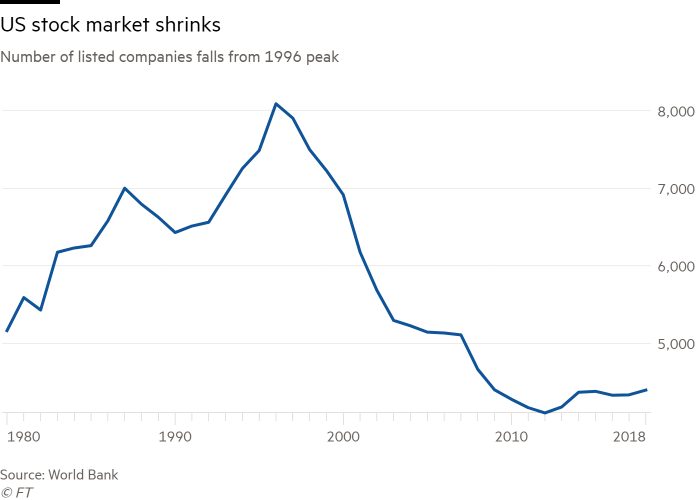
Source: FT, World Bank
This shrinking pool of listed securities is somewhat deceptive, the number of securities that trade on OTC Markets, colloquially referred to as the Pink Sheets (although it includes more than 4,000 names listed on Nasdaq’s OTCBB) currently stands at 11,943, more than double the total of 2010.
This is not simply to do with the onerous nature of listing requirements for the major exchanges, the preference for private over public also shows up in the value of IPOs versus Venture Funds: –
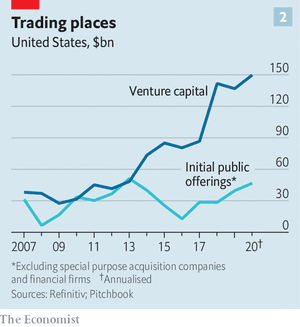
Source: The Economist
There is also a rising preference for debt financing, rather than equity issuance, a more direct effect of the financial repression of artificially low interest rates, which is evident, not just in the US but, at a global level: –
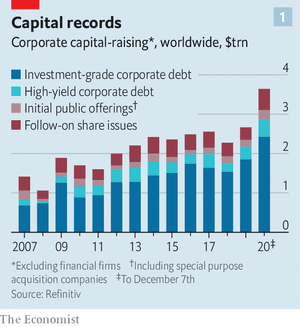
Source: The Economist, Refinitive
A number of other equity valuation metrics are in the top percentile of their historic ranges: –
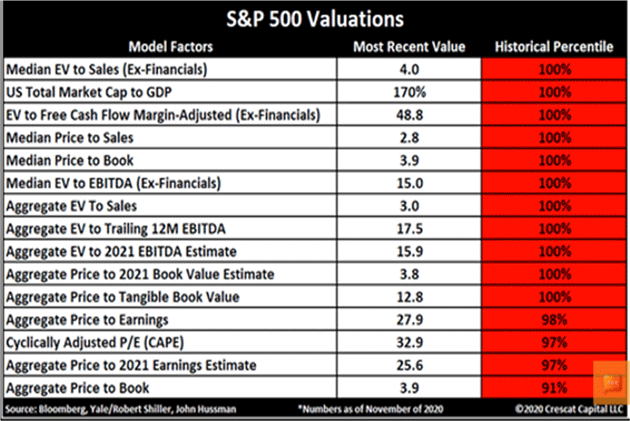
Source: Crescat Capital, Doug Kass, Bloomberg, Yale, John Hussman
The Felder Report – What Were You Thinking? Goes further, observing the percentage of companies with a multiple of sales valuation exceeding 10: –
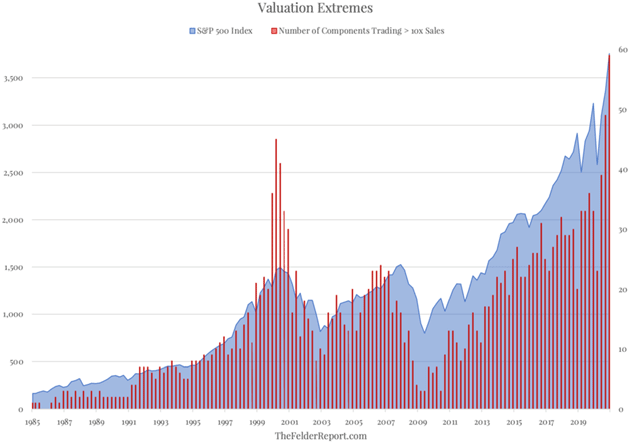
Source: The Felder Report
For the author, this is redolent of the Dotcom bubble of 1999. As for the title of his recent blog?
“What were you thinking?” That is the rhetorical question Scott McNealy, CEO of SunMicrosystems, asked of investors paying a “ridiculous” ten times revenues for his stock at the height of the Dotcom Mania. The incredulity in his voice is amplified by the benefit of hindsight as McNealy gave the interview this quote was taken from in the wake of the Dotcom Bust, after his stock price had lost over 90% of its value.
The Yield Dilemma
Another way to look at the valuation of stocks is to chart the earnings yield: –
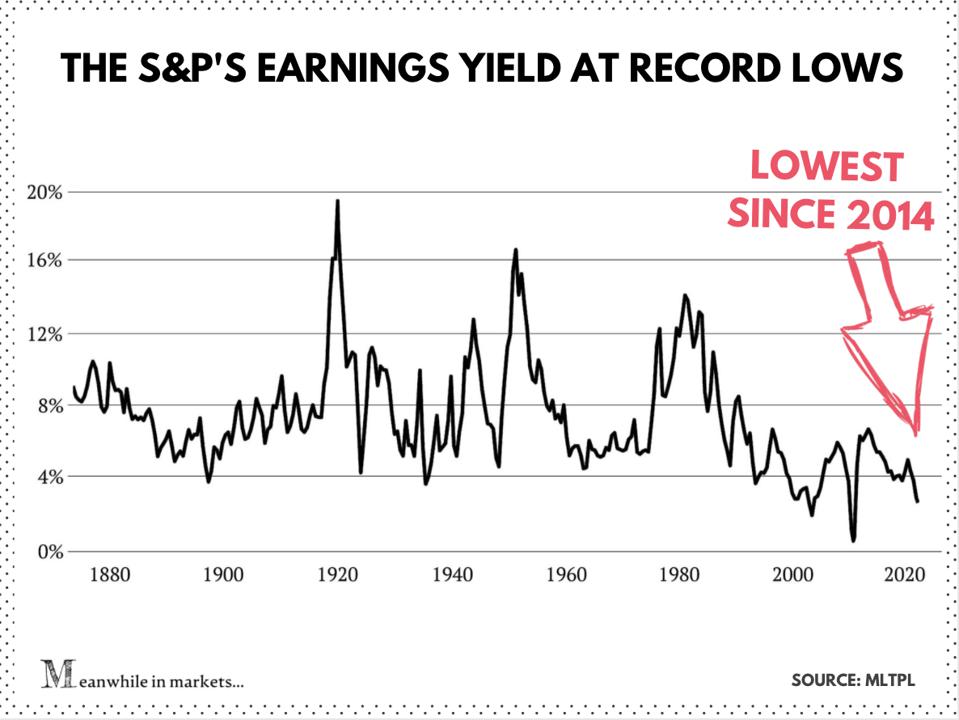
Source: Meanwhile in the Markets, MLTPL
However, to get a more realistic picture you need to compare the earnings yield of stocks against the yield of US Treasuries, after all, investors need to put their money somewhere: –
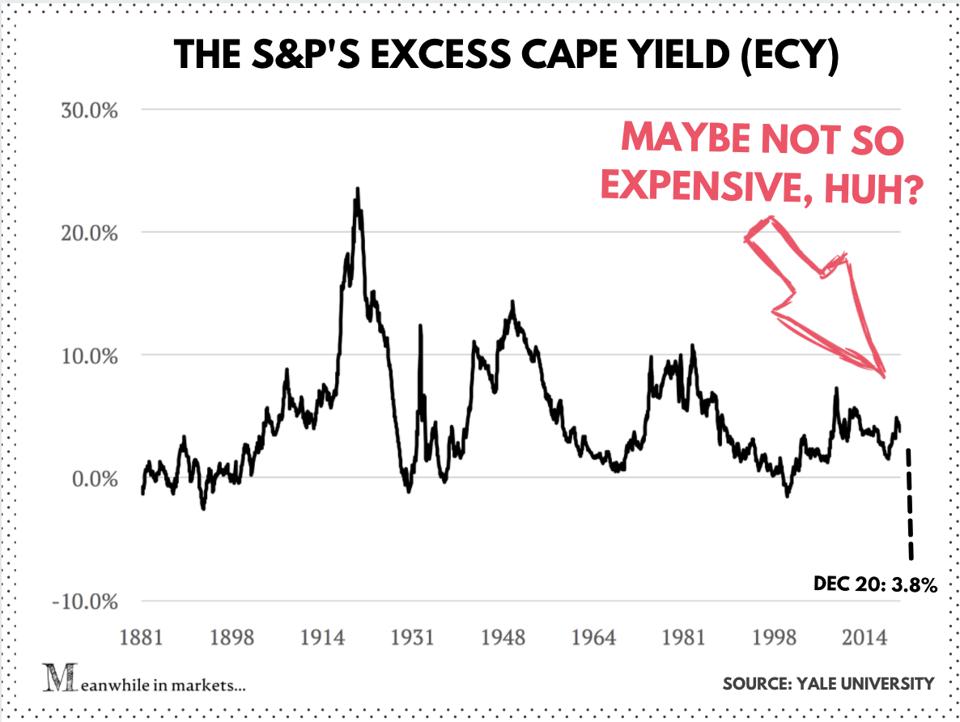
Source: Meanwhile in the Markets, Yale
Writing in Forbes – Dan Runkevicius – The Stock Market Is The Most Attractive Since 1980, Nobel-Winning Economist Says – the author concludes: –
By this measure, the S&P is the most attractive against bonds since 2014. Nobel-prize winning economist Robert Shiller—who came up with the CAPE ratio—wrote in a recent paper:
“With rates so low, the excess CAPE yield across all regions is almost at all-time highs, indicating that relative to bonds, equities appear highly attractive.”
If the Federal Reserve are toying with the idea of introducing yield-curve control – a policy currently adopted by the Bank of Japan – then stocks become the onlyliquid game in town. If you think the idea of the Fed following the Japanese model is anathema, this Federal Reserve article – How the Fed Managed the Treasury Yield Curve in the 1940s – might give you pause for thought: –
By mid-1942 the Treasury yield curve was fixed for the duration of the war, anchored at the front end with a ⅜ percent bill rate and at the long end with a 2½ percent long-bond rate. Intermediate yields included ⅞ percent on 1-year issues, 2 percent on 10-year issues, and 2¼ percent on 16-year issues…
In late November 1950, facing the prospect of another major war, the Fed, for the first time, sought to free itself from its commitment to keep long-term Treasury yields below 2½ percent. At the same time, Secretary of the Treasury John Snyder and President Truman sought a reaffirmation of the Fed’s commitment to the 2½ percent ceiling.
The impasse continued until mid-February 1951, when Snyder went into the hospital and left Assistant Secretary William McChesney Martin to negotiate what has become known as the “Treasury-Federal Reserve Accord.” Alan Meltzer has observed that the Accord “ended ten years of inflexible [interest] rates” and was “a major achievement for the country.”
Given that the Covid-19 pandemic has had a war-like impact on the global economy, it is not unreasonable to anticipate a decade of near-zero US interest rates. Perhaps the Fed Hawks will prevail, but here is what US inflation did between 1941 and 1951: –
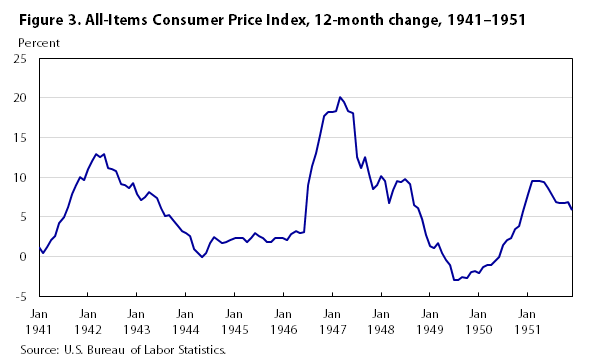
Source: BLS
After the inflationary experience of the 1970’s and 1980’s, the Federal Reserve may not have quite the tolerance for inflation that they had in the 1940’s, but when the least painful solution to the current debt crisis is inflation, the Fed may turn out to be far more tolerant of a rising price level than the markets are thinking at present.
A final factor when considering the performance of the US stock market is the amount of cash available for investment. When we look at the Mutual Fund market there is cause for concern, but the record low levels of cash available to mutual fund managers is itself a function of the poor return available on cash. This post from Lance Roberts – Why There Is Literally No “Cash On The Sidelines” – elaborates on the topic, but the chart below suggests that this trend is by no means new: –
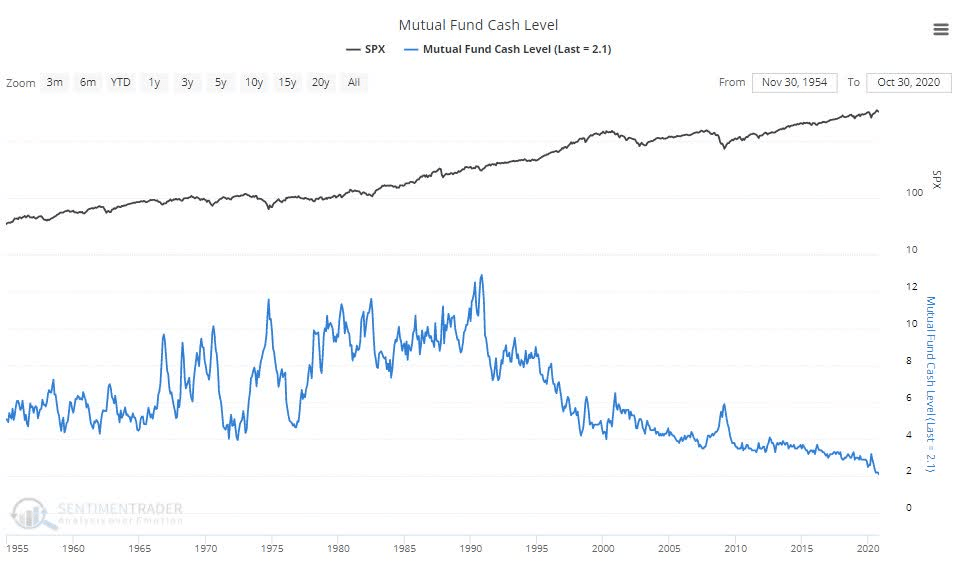
Source: Real Investment Advice, Sentiment Trader
The other side of the cash debate concerns the rapid increase in the US personal savings rate which has accompanied the lockdown restrictions. This post fromthe Federal Reserve Bank of Kansas City – Why Are Americans Saving So Much of Their Income? – looks at the topic in more detail, however,the chart below supports my supposition that, as savings have risen, so too has the percentage of windfall payments which are invested rather than saved or consumed: –
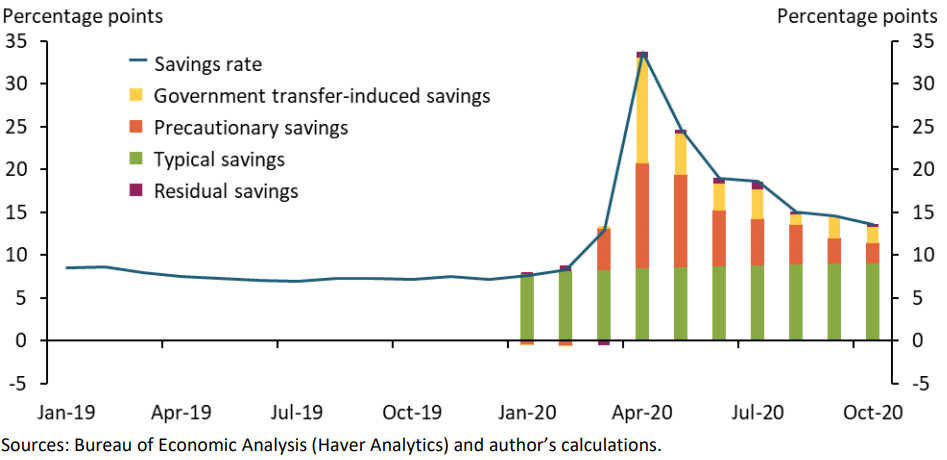
Source: BEA, Haver Analytics, KC Fed
The author, A. Lee Smith is, of course, concerned with direction of consumption spending, concluding: –
As fiscal support lapses and forbearances expire, the strength of U.S. consumption is likely to be tested in the coming months. Recent increases in the personal savings rate have stirred hope that consumption will remain resilient. However, I find that such optimism may be misplaced, as past increases in the savings rate have failed to predict future consumption behavior.
An important caveat to this conclusion is that the unprecedented nature of this crisis could lead to departures from historical patterns. The sheer size and scope of recent government transfers, for example, could support spending once the pandemic recedes. However, the scarring nature of the crisis and previously unimaginable income risk could just as easily have given consumers a lasting desire to increase their liquidity buffers and guard against future income losses. After the Great Recession, for instance, Gallup surveys show a persistent increase in the share of consumers who prefer to save rather than spend (Saad 2019).
The uneven imprint of this crisis across the economy, which my aggregate analysis overlooks, could also lead to a departure from historical savings and consumption patterns. While many consumers may now have the desire to save more, only those that remain employed have the ability to actually save more. This distinction between desired and actual savings is important, as a pullback in consumption by employed households could amplify income losses for unemployed households in hard-hit sectors. This sectoral dynamic leaves little reason to be optimistic about future spending based on the elevated savings rate. In particular, if employed households are forgoing vacations and travel, forgone consumption today is unlikely to be made up in the future, creating a lasting income loss for many households.
If the author is correct, the likelihood of Federal Reserve tapering is very low indeed.
Conclusions
To arrive at a conclusion about current the value and near-term future prospects for equities, we also need to look at a range of shorter-term factors. This will be the focus of the second part of this letter.Posted in Uncategorized | Tagged equities, interest rates, stocks | Leave a comment
Podcast with Max Gottlich – 22-01-2021


